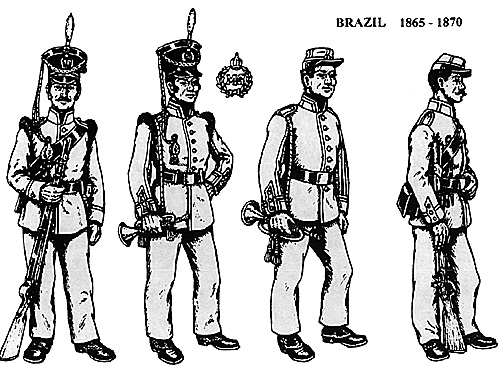This was, of course, the original full dress uniform, authorized in 1852. Within a few years it was Modified by extending the cuff flaps of the "second" uniform to the full dress tunic (for Sao Paulo, these would be light blue on dark blue cuffs, all piped red).
FIG. 2: Hornist ("Corneta"), Cacadores of Matto Grosso, Full Dress c.1865: shako as for the last figure except the initials "M.G." on the plate. Dark blue tunic with green collar and cuff flaps, dark blue cuffs and shoulder straps, all edged with red piping including the front opening, black shoulder rolls, brass buttons; a broad yellow tape with red centre stripe edges the collar and cuffs, and down the front and rear seams of the sleeve. Dark blue trousers, white gloves, black belt and gaiters, brass horn with green cords and tassels.
The detail figure to the right illustrates the standard pattern shako plate for "Fixed Corps": a wreath of laurel branches with the Imperial crown above, the provincial initials inside. A number of the "Barroso" plates show the cuff flaps coming to a point at the top as depicted here.
FIG. 3: Hornist, Cacadores of Pernambuco, "Second" or undress Uniform, c.l865: dark blue kepi with red band, yellow horizontal and vertical piping (presumably indicating a general uniform modification, rather than a special musician's distinction?), national cockade on the front, black chinstrap. Dark blue tunic, including collar, cuffs and shoulder straps, red rectangular collar patches, dark blue cuff flaps, all piped with yellow, brass buttons, yellow and red tape as for the last figure. Dark blue trousers, black belt and gaiters, green trumpet cords.
FIG. 4: Cacador, Fixed Corps of Sergipe, Undress or Service, c.1865: dark blue kepi and band, trimmed with green piping. Dark blue tunic, collar and collar patch, cuffs and shoulder straps, all green piping and cuff flaps, brass buttons. White summer trousers, black gaiters and belts. His pouch belt is depicted as having a square or rectangular brass plate on the breast (these "Fixed Corps" would seem to have used a variety of equipment models, some being depicted with only a waistbelt, while others have a mixed equipment with the pouch on a bandolier combined with a waistbelt).

Uniform Plates
Back to Table of Contents -- El Dorado Vol VIII No. 2
Back to El Dorado List of Issues
Back to MagWeb Master Magazine List
© Copyright 1998 by The South and Central Military Historians Society
This article appears in MagWeb (Magazine Web) on the Internet World Wide Web.
Other military history articles and gaming articles are available at http://www.magweb.com